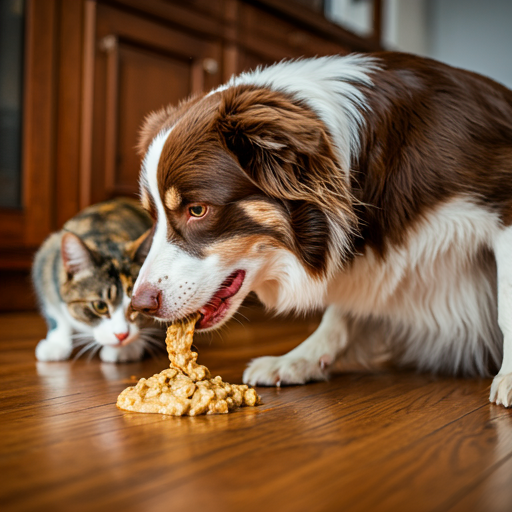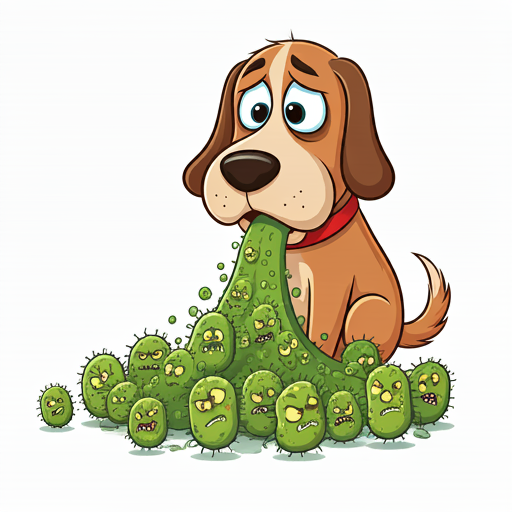97 Gag or Barf? Decoding regurgitation and vomiting in dogs
Ambareen Abbas; Abigail Clanton; and Lillian Schmitz
Gag or Barf? Decoding Regurgitation and Vomiting in Dogs

How can you tell the difference between regurgitation and vomiting in dogs?
Why can your dog spit up its food so quickly after eating, but you take much longer to throw up if you feel sick?

Basic anatomy of the dog’s digestive system
Learning objectives
At the end of this lesson, you will be able to identify the physical differences between regurgitation and vomiting and explain the internal process of each.
By the end of this lesson, you’ll be able to:
- Explain the key differences between regurgitation and vomiting.
- Describe how the body processes each action.
- Identify treatments for common causes of regurgitation and vomiting.
- Understand why knowing this matters in veterinary care.
What’s Happening Inside?
Regurgitation:
- What it is: A passive process where food or liquid is brought back up from the esophagus without nausea or force.
- How it happens: The esophagus relaxes, and undigested food flows back up.
- Why it happens: Could be because of eating too fast, a condition like esophageal obstruction, or structural issues.
- What it looks like: Food is undigested, tubular in shape (still looks like kibble or whatever was eaten), and usually happens soon after eating.
Vomiting:
- What it is: An active process where the stomach forces its contents back up through strong muscle contractions.
- How it happens: The brain’s vomiting center is triggered (by toxins, motion sickness, or illness), the stomach contracts, and nausea usually comes first.
- Why it happens: To get rid of something harmful, like spoiled food or toxins.
- What it looks like: Food is partially digested, often mixed with bile (yellow-green fluid), and smells very sour.
How do we fix these problems?
When we look at a condition like regurgitation or vomiting, they can either occur once or many times in a short time period. If it happens just once it may not be as much of a concern, and will likely resolve on its own and not continue. However, if it is reoccurring it could be due to disease or a structural abnormality in the dog. The treatment depends on the underlying cause. Listed below are a few standard causes and ways to reduce the frequency or stop regurgitation or vomiting in dogs.
- Regurgitation:
Cause
Solution(s)
Enlarged esophagus or issues with moving food down the esophagus - Feeding small, frequent meals to avoid overloading the esophagus.
- Medications that help protect the esophagus or reduce acid in the stomach. Too much acid can lead to more regurgitation!
- Slow feeding bowls reduce how quickly the dog eats.
Something blocking the pathway of the esophagus - Remove the blockage
Tumors or structural abnormalities - Can be removed or adjusted surgically
Other diseases causing regurgitation - Can be managed with diet and medication depending on the condition
- Vomiting:
Cause
Solution(s)
Idiopathic (we do not know the cause) vomiting - Fluids to rehydrate the dog (Lots of fluid is wasted with vomiting, which can lead to dehydration making vomiting and nausea worse!).
- Feeding a “bland diet” such as boiled chicken and rice.
- Medications to reduce vomiting and nausea.
Allergies to food ingredients - Feeding a hydrolyzed diet that removes allergens from the dog’s food.
Changes in the diet- feeding new foods or new treats - Stop feeding the food or treat that is causing vomiting.
Poison or toxins - This can be an emergency! Typically fluids are given to flush the system and occasionally charcoal to absorb any extra toxins inside the gut. In this case, it is a good thing the dog is vomiting to remove any consumed toxins.
Other diseases cause vomiting - Can be managed with diet and medication depending on the condition.
A Fun Comparison:
Think of regurgitation as your esophagus saying, “Oops, let’s send that back.” Vomiting is like your stomach yelling, “Emergency! Get this out—NOW!”


Activities
Decide whether each statement is true or false.
Practice what you have learned about regurgitation and vomiting in dogs. What do you remember about the signs, causes, and treatments for each?
Assessment
Answer the following:
Further exploration
Test what you know about the different treatments for each condition!
Want to learn more? Check out these articles!
Vomiting or regurgitation in dogs and cat
Images created by the authors and are CC for NC use

